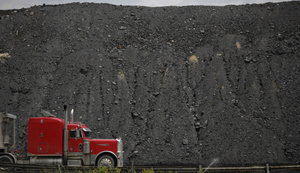The Environmental Protection Agency’s proposed regulations to reduce carbon emissions are generating heated debate about climate change. But one thing is clear: companies need to do much more to explain to investors the climate-related risks they face and how they are managing them.
美国环境保护署(Environmental Protection Agency)拟定的减少碳排放提案正在引发一场关于气候变化的激烈辩论。但有一点是明确的:企业需要向投资者更加详尽地解释它们面临的气候变化相关风险,以及它们正在采取的管控措施。
Extreme weather events appear to be getting more severe and more frequent, as the recent drought in California and floods in Europe reminded us. Weather events accounted for 90% of natural catastrophe losses in 2013, causing over $120 billion of losses, according to reinsurance company Munich Re. In 2012, the overall effect of climate events on the US and European economies is estimated at more than $5 trillion for each region, or over 30% of their GDP.
加州近期的大干旱和欧洲的洪水提醒我们,极端天气事件正变得越来越严重,越来越频繁。根据慕尼黑再保险公司(Munich Re)提供的数据,天气事件占2013年自然灾害损失的90%,共造成1,200多亿美元的损失。该公司估计,2012年,气候事件对美国和欧洲经济的总体影响均超过5万亿美元,占各自国内生产总值(GDP)的30%以上。

The investment community – along with regulators – has woken up to this threat. It is demanding more information from companies about their exposure to climate events, as well as the prospective cost of their carbon emissions.
除了监管机构以外,投资界也已经意识到了这种威胁。投资人正在要求公司披露更多关于气候事件风险的信息,以及碳排放的预期成本。
A wide range of businesses – not just insurers and carbon intensive corporations – are being pressed to demonstrate how they are managing these long-term issues. Their future cost of capital will in part hinge on the answers they give.
身处多种行业的公司——不仅仅是保险公司和碳排放密集型企业——正在被要求披露它们管控这些长期问题的措施。这些企业未来的资金成本在某种程度上将取决于它们给出的答案。
Unfortunately, too many businesses still provide investors and other stakeholders only a partial picture of the risks they face. And they offer an incomplete explanation of how they are mitigating these exposures.
不幸的是,太多的企业仍然只为投资者及其他利益相关者提供各自面临风险的部分图景。在阐述它们如何减轻这些风险的时候,这些企业的解释是不完整的。
The corporate sector is nimble at meeting growing investor demand for environmentally-friendly assets. Private sector companies’ issuance of green bonds, which fund environmentally beneficial capital investment, is growing rapidly. According to Standard & Poor’s, it is likely to double this year to around $20 billion.
公司部门正在非常敏捷地满足投资者对环境友好型资产不断增长的需求。私营公司发行的绿色债券(这类债券的所筹资金用来资助有利于环境的资本投资)急剧增长。据标准普尔公司(Standard & Poor’s)估计,这类债券的规模今年很可能翻一番,达到200亿美元左右。
However, businesses are proving much slower in providing investors with robust information about their wider climate and carbon-related risks.
但事实证明,就向投资者提供更广泛的气候和碳排放相关风险的可靠信息而言,许多企业的动作要慢得多。
Climate risk, along with the impact of carbon pricing, carries direct and indirect exposure for a company. It potentially affects its entire value chain, from production through to distribution and sales. Floods and blizzards disrupt suppliers and dislocate manufacturing, but they also can curb consumption.
气候风险,以及碳定价的影响,将导致公司面临直接和间接风险。从生产到流通和销售,这类风险可能会影响公司的整个价值链。洪水和暴风往往会打乱供应商的部署,使得制造流程陷入混乱,还可能抑制消费。
Over the long-term, extreme weather can damage both profitability and asset valuations in unexpected ways. Companies that fail to take account of these risks may suffer significant stress and have little flexibility to manage their exposure.
从长远来看,极端天气会以意想不到的方式损害企业的盈利能力和资产估值。不重视这些风险的公司可能会承受巨大压力,并且很难灵活地管控它们面临的风险。
Companies frequently focus on communicating their direct liability to carbon emissions regulation, notably the net cost of carbon permits they are required to hold under emissions trading schemes. These costs are important and, notwithstanding the recent decline in carbon credit prices, are likely to grow over time. But many companies ignore the – potentially much larger – costs of a carbon liability being passed down the supply chain or changing end demand for products and services.
公司通常很注重披露碳排放法规施加给它们的直接负债,特别是为获得排放交易计划要求持有的碳排放许可证而支付的净成本。这些成本的重要性无需赘言,尽管碳排放信用额的价格最近有所跌落,但随着时间的推移,这些成本很可能将继续增长。但很多公司忽视了一项正在沿着供应链传递,或者正在改变产品和服务终端需求的碳负债成本,而这项成本可能要大得多。
Energy, materials, industrial and utility companies have the highest direct carbon intensity and therefore the largest regulatory exposure to emissions compliance schemes.
能源,材料,工业和公用事业公司具有最高的直接碳排放强度。因此,碳排放计划施加给这些企业的监管风险也是最大的。
But the property and financial services sectors are also exposed to climate risk due to the life cycle of buildings and the nature of their long-term investments. All sectors, in fact, are affected in varying degrees, to climate and carbon risks.
但是,由于建筑物的生命周期和长期投资的性质,房地产和金融服务行业亦面临气候风险。事实上,所有行业都或多或少地受到气候和碳风险的影响。
Conventional financial analysis of carbon risk overlooks the “shadow liability” caused by potential carbon price liabilities from indirect exposures across the value chain.
针对碳风险所做的传统财务分析往往会忽略“影子负债”——它是整个价值链面临的间接风险有可能产生的碳价格负债所导致的。
This shadow liability is hard to analyze, as data is patchy and valuation methods vary. Inconsistent disclosure requirements around the world do not help either.
我们很难分析这种影子负债,因为相关数据非常零散,估值方法也不尽相同。世界各地不一致的披露要求同样无助于这种分析。
In the U.S., the SEC requires firms that file annual reports to communicate material climate change risks. In April, the European Parliament approved new rules that will require large listed firms to publish environment and social data in their reporting to investors. But this falls far short of a comprehensive and coordinated disclosure regime for companies’ overall exposure to carbon and climate risk.
美国证券交易委员会(SEC)要求企业在提交年度报告时披露实质性的气候变化风险。今年4月份,欧洲议会批准一项新规则,要求大型上市公司在它们提交给投资者的报告中发布环境和社会数据。但仅凭这些措施,还远远不足以形成一个全面且可协调,针对公司面临的全部碳和气候风险的披露机制。
Investors, meanwhile, are not standing still. They are starting to conduct their own analysis of indirect carbon price risk and its impact on corporate investment returns and credit quality.
与此同时,投资者并没有无动于衷。他们自己已经开始分析间接的碳价格风险及其对企业投资回报率和信贷质量的影响。
Independent analysts who serve them are doing the same. S&P, for instance, is seeking to assess the effects of carbon price risk on a company’s creditworthiness by considering the direct and indirect impact of profitability, asset and liability valuation, and cash flow. Organizations like the international Carbon Disclosure Project are surveying companies about their environmental exposures and scoring them accordingly.
服务于投资者的独立分析师也正在从事这类分析。比如,标准普尔公司正在估算盈利能力,资产及负债估值和现金流遭受的直接和间接影响,以评估碳价格风险对公司信誉的影响。像碳信息披露项目(Carbon Disclosure Project)这类国际组织正在调查公司面临的环境风险,并给予它们相应的评分。
Some large companies are responding. Exxon Mobil recently became the first oil and gas producer to publish details of its climate risk exposure from stranded assets (reserves that it could not exploit if regulation is tightened). But most businesses are yet to accept that climate and carbon risks are ever more material to corporate performance and value.
一些大公司正在作出回应。埃克森美孚(Exxon Mobil)最近成为第一家详尽发布其搁浅资产(即如果调控收紧,该公司就不能开采的资产储量)气候风险信息的石油和天然气生产商。但大多数企业尚未接受气候和碳风险对企业绩效和价值的影响将日益加大这个事实。
Business leaders should acknowledge that climate risk and carbon liabilities are here to stay and, in all probability, set to grow. If they cannot demonstrate effective assessment and management of these short-term and long-term liabilities, their creditworthiness may suffer and their financing costs will rise.
企业领导者应该认识到,气候风险和碳负债是切实存在的,而且注定会继续增大。如果他们不能有效地评估和管理这些短期和长期负债,公司信誉或将遭受重创,融资成本就将上升。
Capital markets participants traditionally have short term horizons. But environmental change is a long-term issue that they cannot ignore. Over time, it will play an increasing role in determining both financial risk and return.
资本市场的参与者通常只关注短期图景。但环境变化是一个不容忽视的长期问题。随着时间的推移,环境变化在决定财务风险和回报方面的作用将越来越大。
Neeraj Sahai is president of Standard & Poor’s Ratings Services.
本文作者Neeraj Sahai是标准普尔评级服务公司总裁。













